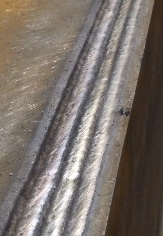Submerged arc welding is a proven processes with many benefits, including high productivity and high quality. It is particularly suited to welding on large fabrications in series production. There are a number of process steps that are important during the SAW welding process to insure that high quality welds are produced. K&M Machine-Fabricating, Inc. uses the SAW process to weld large fabrications for series production.
Submerged arc welding was first used in the 1930’s. Today’s SAW equipment and processes are the result of many years of production use and improvements. Advantages of the SAW process are high deposition rates, deep weld penetration, and high productivity.
The SAW process is similar to the MIG (Metal Inert Gas welding). The SAW process uses a flux that is granular. The flux is used to generate shielding gases and slag and to add alloying elements to the weld pool. Picture # 1 shows the flux around the welding electrode.

Picture # 1 – Flux Deposited in Front of Welding Electrode
K&M Machine-Fabricating, Inc. has two ESAB CaB300 Sub Arc machines. Each of these machines features a 3 meter column travel, 3 meter boom travel and they are mounted on a 50 foot long rail carriage. The size and travel of these machines are well suited for welding large fabrications. The machines are equipped with joint tracking and positioning capability. The welding heads are 1250 Amps. The Plasma gouging heads are 150 amp. The K&M Youtube channel features a video of the Subarc machine in action (link). This article will describe the Subarc process that is featured in the video. Picture # 2 below shows one of the subarc machines at K&M. The large fabrication that is in process is shown located to the right of the subarc machine.

Picture # 2 – Subarc Machine at K&M with Large Fabrication in Location
The weld demonstrated in the K&M video is typical of the welds produced using the subarc process at K&M. This joint is a 60 degree bevel. This weld joint requires 100% penetration and 100% UT inspection. Prior to positioning in the subarc machine a backing weld is applied to the weld joint on the large fabrication. Picture # 3 shows the weld joint prior to the plasma gouging and subarc welding that takes place on the subarc machine.

Picture #3 – Weld Joint Prior to Plasma Gouging
The first step in the welding process for the large fabrication on the sub arc machine is to plasma gouge the joint. This process is required to insure that 100% penetration is achieved in the welding process. Picture # 4 shows the weld joint after plasma gouging.

Picture # 4 – Weld Joint After Plasma Gouging
After the plasma gouging operation the weld joint is ground with a grinding wheel to clean the joint and to achieve the proper weld joint geometry. The weld joint geometry is checked with a template gage. Picture # 5 shows the weld joint after grinding. The weld joint is also cleaned with a wire wheel.

Picture # 5 – Weld Joint After Grinding
A root pass is applied to the weld joint with the Flux Core (FCAW) welding process prior to welding with the sub arc machine and sub arc process. Picture # 6 shows the root pass in place in the weld joint.

Picture # 6 – Root Pass
The weld is cleaned with a chipping hammer and wire wheel after the root pass and between all SAW weld passes. After cleaning the first SAW pass is welded. Picture #7 shows the SAW welding in-process. The cooling molten slag can be seen to the right of the picture.

Picture # 7 – SAW Welding in Process
On a large fabrication the size of the weld joint will often require multiple SAW passes. Interpass cleaning and inspection is a critical part of the welding process. Any irregularities must be found between passes. Finding indications after all passes are complete will require repair of the weld joint. Repair costs will detract from the cost savings that were achieved by using the SAW process. Picture # 8 shows multiple passes and cap passes.

Picture # 8 – Multiple SAW Passes
The SAW process produces a weld that is visually appealing. Not only is it a high quality weld (these welds are 100% UT inspected), it looks like a high quality weld. Picture #9 shows the finished weld after the cap passes are complete. K&M’s customers, their customers, and the user in the field appreciate the high quality and good visual appearance of the SAW welds.

Picture #9 – Cap Passes
The SAW process is one of the many welding processes that K&M uses to manufacture large fabrications. The same focus on welding processes and quality that is used in the SAW process is used in all of K&M welding processes.